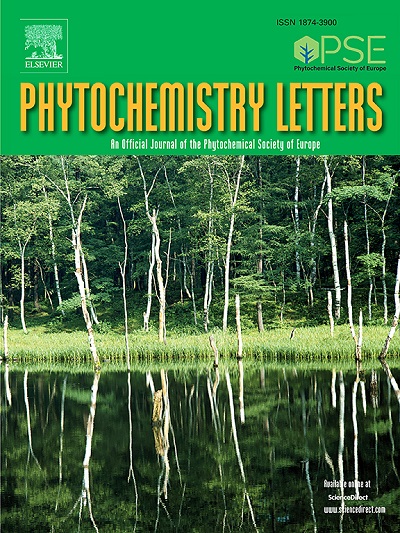Two new ursane type triterpenoids from adult leaves of Cyclocarya paliurus
IF 1.4
4区 生物学
Q4 CHEMISTRY, MEDICINAL
引用次数: 0
Abstract
A phytochemical study on the adult leaves of Cyclocarya paliurus led to the isolation of two new ursane type triterpenoids 2α,3β,23-trihydroxy-taraxastan-28,20β-olide (1) and 3β,11α,19α,24,30-pentahydroxy-20β,28-epoxy-28β-ethoxy-ursane (2), along with four known analogs, 2α,3α-23-trihydroxyurs-12-en-28-oic acid (3), hederagenin (4), quinatic acid (5) and arjunolic acid (6). Their structures were elucidated on the basis of extensive spectroscopic analysis including 1D, 2D NMR and MS techniques. These triterpenoids were tested for their in vitro α-glucosidase inhibitory activity with acarbose and corosolic acid as references. All of these compounds, except 2, were found to show obvious in vitro α-glucosidase inhibitory activity with MIC values ranging from 0.017 to 0.106 mM, which were much stronger than acarbose (IC50 0.408 mM). Especially, 3, 4 and 6 showed in vitro α-glucosidase inhibitory activity with MIC values (IC50 0.034, 0.017 and 0.041 mM) close or even more potent than corosolic acid (IC50 0.033 mM). The present result supported that the adult leaves of C. paliurus was also a rich resource for potential anti-diabetic chemicals worthy of further investigation.
圆叶环己烷成虫叶中两个新的哺乳类三萜
通过对环绿树成虫叶片的植物化学研究,分离到2个新的熊类三萜2α,3β,23-三羟基-taraxastan-28,20β-olide(1)和3β,11α,19α,24,30-五羟基-20β,28-环氧-28-乙氧基熊类(2),以及4个已知的类似物2α,3α-23-三羟基-12-en-28-oic酸(3),hederagenin (4), quinatic acid(5)和arjunolic acid(6)。通过广泛的光谱分析,包括一维、二维核磁共振和质谱技术,对它们的结构进行了鉴定。以阿卡波糖和花椰树酸为对照,测定了三萜体外α-葡萄糖苷酶抑制活性。除2外,其余化合物均表现出明显的体外α-葡萄糖苷酶抑制活性,其MIC值为0.017 ~ 0.106 mM,远高于阿卡波糖(IC50为0.408 mM)。特别是3、4和6的α-葡萄糖苷酶体外抑制活性,其MIC值(IC50分别为0.034、0.017和0.041 mM)接近甚至高于花椰果酸(IC50分别为0.033 mM)。本研究结果表明,黄菖蒲成叶也是一种丰富的潜在抗糖尿病化学物质资源,值得进一步研究。
本文章由计算机程序翻译,如有差异,请以英文原文为准。
求助全文
约1分钟内获得全文
求助全文
来源期刊

Phytochemistry Letters
生物-生化与分子生物学
CiteScore
3.00
自引率
11.80%
发文量
190
审稿时长
34 days
期刊介绍:
Phytochemistry Letters invites rapid communications on all aspects of natural product research including:
• Structural elucidation of natural products
• Analytical evaluation of herbal medicines
• Clinical efficacy, safety and pharmacovigilance of herbal medicines
• Natural product biosynthesis
• Natural product synthesis and chemical modification
• Natural product metabolism
• Chemical ecology
• Biotechnology
• Bioassay-guided isolation
• Pharmacognosy
• Pharmacology of natural products
• Metabolomics
• Ethnobotany and traditional usage
• Genetics of natural products
Manuscripts that detail the isolation of just one new compound are not substantial enough to be sent out of review and are out of scope. Furthermore, where pharmacology has been performed on one new compound to increase the amount of novel data, the pharmacology must be substantial and/or related to the medicinal use of the producing organism.
 求助内容:
求助内容: 应助结果提醒方式:
应助结果提醒方式:


